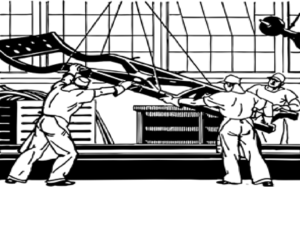The best-running manufacturing plant I ever worked in (and I’ve worked in a lot of ‘em) used no Continuous Improvement (CI) methodologies.
No Lean, no Six Sigma, no TPM, no TPS, no TQS, none of it (at least none in any programmatic way – though I don’t think you can run a manufacturing plant without some activity that one of those programs now claims as its own).
The worst-running plant I ever worked in also used no CI methodologies.
They were the same plant. It was a General Mills cereal plant in Georgia, the smallest one in the Big G division at the time. When I first walked in the door, I was there to help start up the plant’s “new” packaging lines, which had been cobbled together from the old, obsolete cast-off and remnant machines from other plants that had either shut down or gotten actual new equipment. So it ran really, really poorly, at least to start with. (To be fair, the processing side, which had already been in operation making bulk product for several years, ran well. It was the packaging side that was the Achilles heel, because we were new to the game with crappy equipment.)
Over the next five years my team and I quickly and steadily improved those lines, and they went from having the lowest packaging reliability results in the company to the highest. At no time did we employ any of the CI programs that have become de rigueur now.
And I tell you this emphatically: If we had, I’m positive that we would have failed to get the results we did – and we became the lowest-cost producer in the Big G network.
Why? Because far too often, well-intentioned improvement programs get in the way of actual improvement.
Here are a few key areas where many of the CI programs I’ve seen have gone wrong, any one of which almost certainly would have derailed us:
Processes instead of people
At a leadership training event I attended recently (and greatly enjoyed), Barry-Wehmiller trainer David Vander Molen expressed this very criticism of Lean Six Sigma: it’s about machines, and the people who deliver results for us aren’t machines. It really hit home for me, because he put into words what I’ve seen and experienced dozens of times over in failed CI implementations. You can only make lasting improvements by engaging the people who run the systems, and really understanding their struggles and needs – then bringing the required resources to bear to solve their problems, and prioritizing the specific improvements they need rather than what a prepackaged tool tells you to do. Too many CI implementations are hammers seeing only nails, and they force the people to conform to the processes. But as Barry-Wehmiller’s CEO Bob Chapman put it in his book Everybody Matters: The Extraordinary Power of Caring for Your People Like Family, “Lean has become all about numbers, about waste elimination. Does anybody really believe that team members are inspired by the concept of waste elimination?”
At my cereal plant, our system improvements were driven by our technicians on the floor. Before we ever replaced or upgraded a single piece of our aged cereal packaging equipment, we invested in training and development for our people, and made numerous visits to our sister plants that were running better than us to see and learn from how they did things, so we knew what we were aiming for – then we made a people-centered, people-driven plan to get there. It’s not that we never had missteps along the way – but when we did, we adjusted our plan, keeping the focus and ownership with our people – and continued to move forward.
A friend of mine from the flagship plant of a Fortune 500 company, where they’ve been pushing CI programs for 20 years and loudly proclaiming their success, shared with me last week that his plant is “re-launching” its core CI effort – basically pushing the reset button on the exact same process that they now acknowledge has failed. Again, that it – because this is the 3rd or 4th re-launch of that same program at that same site! Forgive the indelicacy, but surely you’ve heard the old adage about polishing a turd…
Bureaucracy instead of results
I was once offered a job at a corporate headquarters as a CI consultant in a central process improvement group. The role specifically served another corporate department that already had its own internal staff of CI consultants!
I’ve long wondered why executives fail to question the existence of whole departments of Black Belts or Subject Matter Experts. The simple question of whether that overhead is paying for itself seems somehow off-limits when it comes to CI. There seems to me to be a herd mentality “easy button” effect at work here – after all, if all the big guys are doing CI, it’s gotta be good, right? But these costs should be scrutinized like every other line on the P&L to be sure you’re getting your money’s worth.
Beyond the money measures, care needs to be taken in how your CI experts behave. If they’re rudely telling long-time plant veterans how to do their jobs based solely on a cookie-cutter process they learned in some stuffy hotel conference room or corporate training center, the work will fail. Unfortunately, I’ve seen that happen many times. An effective CI expert realizes that the real experts are the people running the equipment and making the product – and the rest of us either serve them, or else we’re the waste we want to eliminate.
At my aforementioned cereal plant, other than some corporate packaging engineers who worked our start-up, the good folks at our fellow plants, and some vendor technicians who worked with us on training and troubleshooting, we pretty much helped ourselves and paid our own way. I’ve seen other efforts where CI expertise also paid for itself, when the activities were correctly targeted and the experts served the people doing the real work.
Paperwork, paperwork, paperwork
What’s with all the audits and documents and checklists and reports and such in the CI world? I’ve seen whole centralized databases built just to house forms that were filled out for every single CI activity, and then filed and never looked at again. When you’re burning more energy on the paperwork or presentations than on the actual improvement efforts, you’ve got it wrong.
We had no CI-driven forms or documentation in my cereal plant. We tried stuff the team thought would make us better, and when it improved our teamwork or our reliability or our finances, we kept doing it. If it didn’t, we stopped.
Too many tools at once, for too little benefit
Take a look at the many charts of CI tools here. The sheer numbers and names of the dozens of tools are just staggering. Now, I know that individually, many of these tools have value. But collectively, they’re a freaking nightmare. Too many CI programs are exhaustive lists of tools pushed out as an end in themselves. I remember a particular VP from my past not fondly at all – he tried to boost his career by mandating the launch of a chock-a-block CI program that looked like many of the busier lists at the link above, to be completed in just a few years. It was a giant, costly, exhausting, demoralizing flop. If you haven’t seen that kind of approach in action, you’ll be surprised how quickly people get “tool fatigue” and lose interest in the whole shebang – or even worse, get a permanent “bad taste in the mouth” about all such improvement efforts.
Any tool – the literal kind or the figurative kind – is useful only if it’s what’s needed for the job at hand.
Specialized language that leaves people behind
Take another look at the tool list. “Kano Analysis.” “SIPOC Map.” “RACI and Quad Charts.” “Gantt Charting.” “Pareto Analysis.” “Kappa Studies.” “Takt Time Analysis.” “Kaizen Events.” (I could go on for a long while yet, but…) Now put yourself in the shoes of a production line employee. These are not stupid people – some of the best and smartest people I’ve ever worked with worked on the factory floor. They are also not people who are into ridiculous corporate jargon. Yet we go in and throw around “Gemba” and “Kanban” and “Poka-Yoke” and wonder why they look at us like we’re idiots. Here’s a hint: it’s because we are when we speak and behave this way. Our #1 job as leaders is to engage with people in a way to make them feel comfortable, not to make us feel smarter than everyone else. This is my primary complaint about many CI programs: they seem designed to turn us all into that freshly-graduated engineer who thinks the whole world but him is stupid. (And trust me, I know – I was that engineer lots of years ago.) For the love of all that’s holy, let’s get rid of the obscure terminology and start using basic tools and measures that everybody can understand easily. That’s exactly what we did in my favorite cereal plant, and the results speak for themselves.
In conclusion…
I’m certainly not pushing to throw the baby out with the bathwater here. There are plenty of elements in all the various CI methodologies that have real merit when used appropriately. But unless you begin with your people, engaging with them one-on-one to respectfully encourage them to identify problems and help come up with solutions, and rewarding them for their efforts, you will fail. As many CI launches have shown, you will also likely wind up not eliminating waste, but adding to it with the money you throw out on the failed efforts (oftentimes over and over again). Here’s a good test: if your programs aren’t sustained by the people they’re supposed to be helping without you forcing them, they’re worthless and wasteful. (Look for my coming article on the best 5S project ever for an excellent example of sustained improvement.)
My worst plant became my best plant because we started with a great team and a great work system, and focused on making them better and better with the right training, engagement, empowerment and rewards. I’ll never forget one of my packaging technicians, Eric Morgan, who personally designed a retrofit for our aged cereal baggers to convert them to servomotor drive. I helped him get the money, the detailed engineering design work, and the parts and downtime he needed to make the conversion. We wound up with baggers that were better than new – better, in fact, than the servo-driven baggers the manufacturer of our machines was selling at the time. No CI program would have driven that – Eric did, because he was inspired and confident and he wanted to make things better. And he surely did.
That’s the power of people over process.
If you like what you’ve read here (or even if not!), let me know in the comments, or send me an e-mail at jim@vinoski.net. Please feel free to connect with me on LinkedIn.
©2018 James M. Vinoski. All rights reserved.





